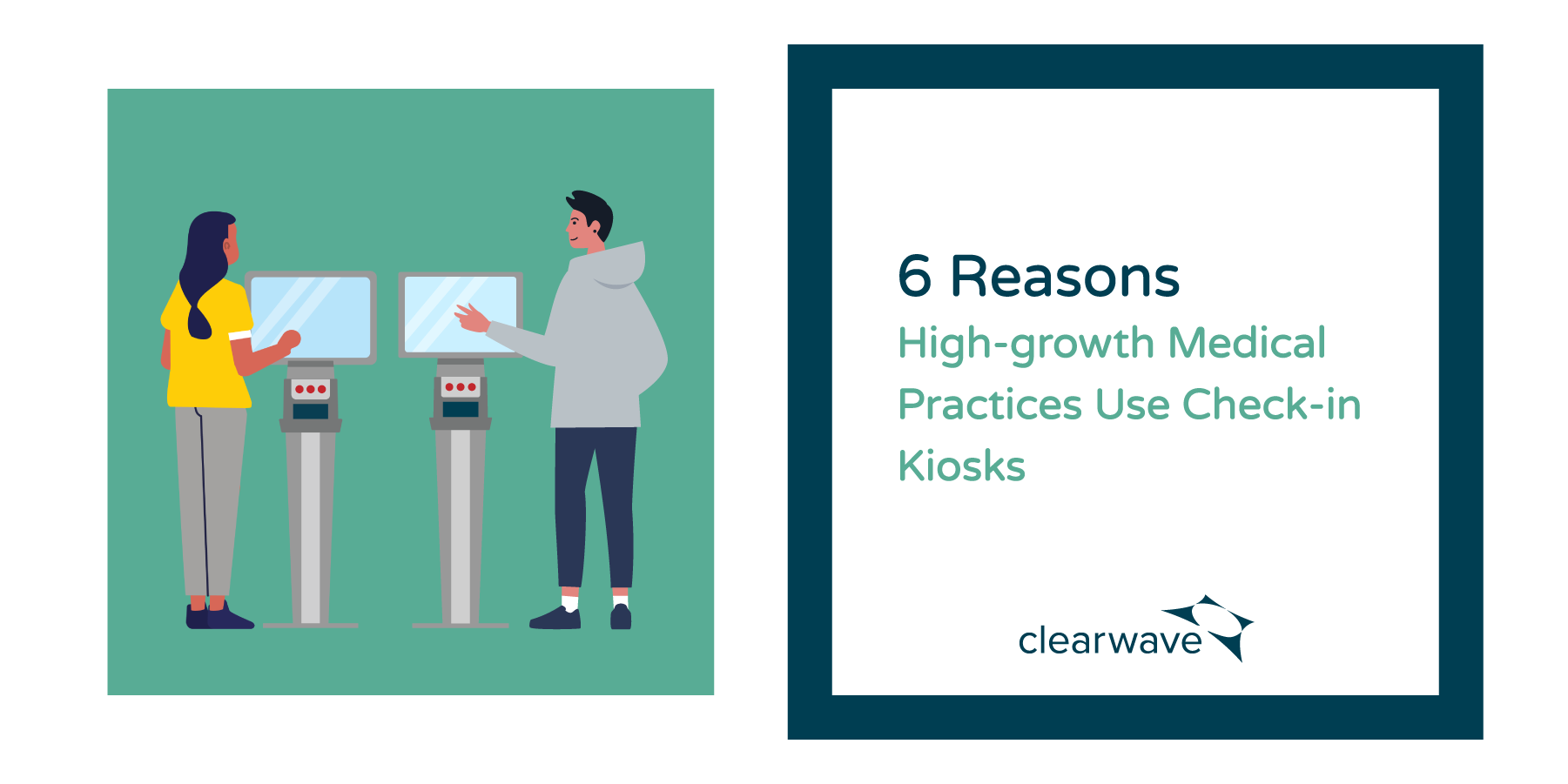6 Reasons High-Growth Medical Practices Use Check-In Kiosks

By Chloe From Clearwave | July 17, 2023
Check-in kiosks have become increasingly popular in various industries, especially medical practices. These self-service stations provide an efficient way for patients to check in for their appointments and make payments, while saving staff the time it would take to check in hundreds of patients a day. Keep reading to learn six reasons why high-growth medical practices consider check-in kiosks essential to their growing revenue growth.
1. Improve Data Capture and Reduce Claims Rejections
Check-in kiosks have helped high-growth medical practices improve their ability to capture data accuracy and minimize claim rejections. The manual process of collecting patient information at the front desk is prone to errors and incomplete entries. Illegible handwriting, missing fields, and data entry mistakes can lead to claim denials and delays in reimbursement. Check-in kiosks can remove these issues.
Practices see that patients are more inclined to update their data when presented it visually, versus being asked when face-to-face with staff. With medical office check-in kiosks, patients can enter their information directly into a user-friendly interface, ensuring that all necessary fields are completed accurately. The comprehensive data collection at the point of check-in enables medical practices to improve claims processing and future patient communications, all with cleaner data. The kiosk software often also includes insurance validation checks and prompts to ensure the data is entered correctly, reducing the likelihood of errors. This streamlined process increases the efficiency of data capture, minimizing the need for manual intervention and decreasing the chances of claim rejections.
By improving data accuracy, medical practices can significantly reduce administrative overhead and expedite the claims submission process. Therefore, check-in kiosks not only enhance the practice’s revenue cycle management but also frees up staff time to focus on patient care and other essential tasks.
2. Increase Collections
High-growth practices see immediate and significant increases to point-of-service collections after implementing medical check-in kiosks. The traditional method of collecting copayments and outstanding balances at the front desk can be time-consuming and may result in missed payment opportunities. Medical check-in kiosks provide a streamlined and convenient process for patients to pay their bills, leading to improved collections for medical practices.
With a high number of patients to check-in every day, staff may be too busy managing a line of patients to ask for payment, or they may simply forget amongst the chaos.. Additionally, staff may feel awkward asking for past-due balances in general, which results in missed revenue opportunities ar ever check in. A self-service kiosk can help mediate these issues. By capturing payments via a self-service check-in kiosk, patients can easily and securely make payments using various methods, such as credit cards, debit cards, or electronic wallets. The kiosk interface can display outstanding balances and copayment amounts enabling patients to understand their financial responsibility upfront. Some solutions also capture card-on-file that your practice can leverage to further accelerate future payments.
The self-service nature of check-in kiosks empowers patients to take control of their payment process and make payments conveniently at the point of check-in. The kiosk software can also generate automatic receipts for patients, providing transparency and ensuring accurate documentation of payments.
The increase in collections through medical check-in kiosks has a direct positive impact on the financial health of high-growth medical practices. It helps in reducing accounts receivable, improving cash flow, and mitigating the risks associated with outstanding balances. By optimizing the payment collection process, medical practices can allocate resources more efficiently and invest in improving patient care and services.
Curious about uncovering hidden revenue during patient check-in? Explore a wealth of valuable strategies and insights in the webinar recording titled “How to Unlock Hidden Revenue During Patient Check-In.” Discover effective ways to maximize revenue opportunities and optimize your check-in process.
3. Streamline Throughput
By automating the check-in process, these kiosks expedite patient registration and reduce waiting times. Using self-service patient check-in kiosks, practices have seen 90% drop in wait times, and even reduced the check-in time to less than two minutes. Medical office check-in kiosks reduce manual paperwork, allowing patients to enter their information directly, speeding up the process.
By freeing up front desk staff from administrative tasks, check-in kiosks also optimize resource allocation, allowing for more personalized attention to patients. Patients appreciate the convenience and control of self-service, resulting in improved satisfaction and engagement.
4. Improve Patient Retention & Positive Reviews
By implementing check-in kiosks, medical practices can create a positive impression and build a reputation for exceptional patient care. A self-service patient kiosk fosters stronger connections and loyalty between patients and the practice. Reducing wait times through efficient check-in processes not only improves patient satisfaction but also increases the likelihood of positive reviews. Patients appreciate the convenience and ease of a fast check-in, leading to comments like “check-in was fast and easy” in their reviews.
The convenience and time saved for patients by eliminating paperwork and dropping waits, creates a positive impression and enhances patient satisfaction, increasing the likelihood of returning to the practice for future healthcare needs. Medical office check-in kiosks also empower patients to participate actively in their healthcare journey. Features that allow patients to review and update their medical history and other information foster a collaborative and patient-centered approach, enhancing trust and loyalty.
By automating check-in, front desk staff will have more time to provide attentive assistance, address patient questions, and create a welcoming environment. These personalized interactions build trust and strengthen the patient’s relationship with the practice.
5. Meet the Needs of All Demographics
Kiosks have become increasingly prevalent in various industries, revolutionizing customer experiences. They are commonly found at airports, allowing travelers to check-in, print boarding passes, and access information conveniently. In grocery stores and restaurants, kiosks enable self-service options for ordering food, making payments, and even customizing meals, providing customers with quick and personalized experiences. Because they are virtually everywhere, patients see and use kiosks frequently, building confidence and their familiarity with self-service.
To provide the self-service experience your patients have come to expect, find a check-in kiosks that benefits all demographics, making them inclusive and accessible for patients of diverse backgrounds, abilities, and age groups. A proven solution will be designed to meet the accessibility guidelines outlined by the Americans with Disabilities Act (ADA). By adhering to ADA standards, medical practices can provide equal access to all patients, promoting inclusivity and eliminating barriers. Incorporating large screen displays in medical check-in kiosks improves readability and usability for individuals with visual impairments or those who prefer a more prominent interface. The larger text and intuitive design enhance the user experience, ensuring that patients of all age groups can easily navigate and interact with the kiosk.
A check-in kiosk should also provide multilingual support, catering to patients whose primary language may not be English. By offering language options, practices can better serve diverse communities, improve communication and ensure that patients can accurately provide their information and understand instructions.
6. Reduce Staff Workloads
Check-in kiosks alleviating the burden of repetitive and tedious check-in tasks for staff handling hundreds of patients daily. By automating the check-in process, medical staff can focus on delivering quality care and personalized attention to patients, resulting in increased efficiency and improved patient satisfaction.
Self-registration kiosks take all the menial check-in work and impersonal interactions off of staff’s plate, like swiping credit cards, asking repetitive questions, capturing card images, data entry and more. Staff won’t have to rush through an endless line of patients or cautiously enter illegible data into your PMS. The implementation of check-in kiosks in high-growth medical practices significantly reduces staff workloads by automating and streamlining these various administrative tasks. With kiosks handling check-in patient requirements, you allow staff members to focus on delivering quality patient care or expanding their knowledge and expertise in other areas of the practice, improving j0b satisfaction.
Resource allocation is also optimized through the automation of the check-in process. By leveraging check-in kiosks, high-growth medical practices can reduce staff workloads and training time associated with administrative tasks, data entry, insurance verification, copayment collection, and communication. Staff members previously assigned to check-in duties can be reassigned to other areas, such as patient care or handling complex administrative tasks, maximizing their efficiency and productivity.
Unlocking Success with Patient Check-in Kiosks
Implementing patient check-in kiosks into your high-growth medical practices, improves data capture, increased collections, streamlined throughput, enhanced patient retention, accessibility for all demographics, and reduced staff workloads.
By leveraging the efficiency and convenience provided by check-in kiosks, medical practices can enhance patient experiences, optimize operations and drive their growth in the dynamic healthcare landscape. Learn the four key ways patient self-registration can help your practice fuel growth! Watch this on demand webinar.




